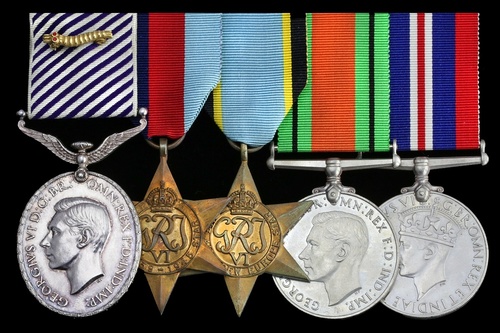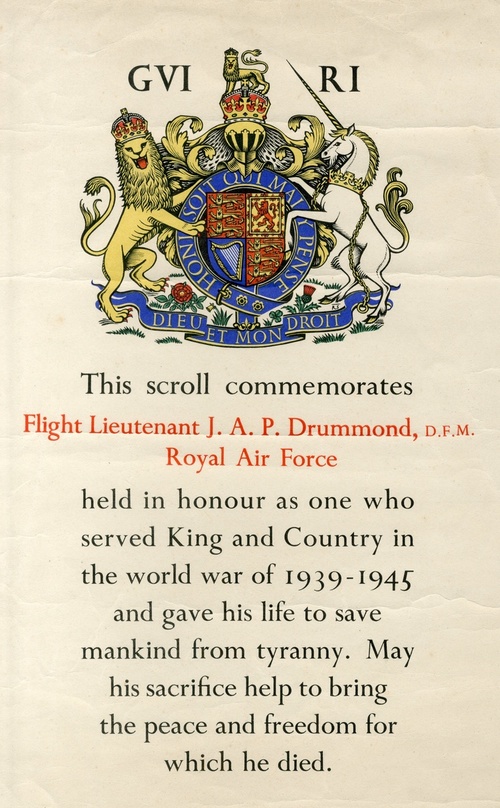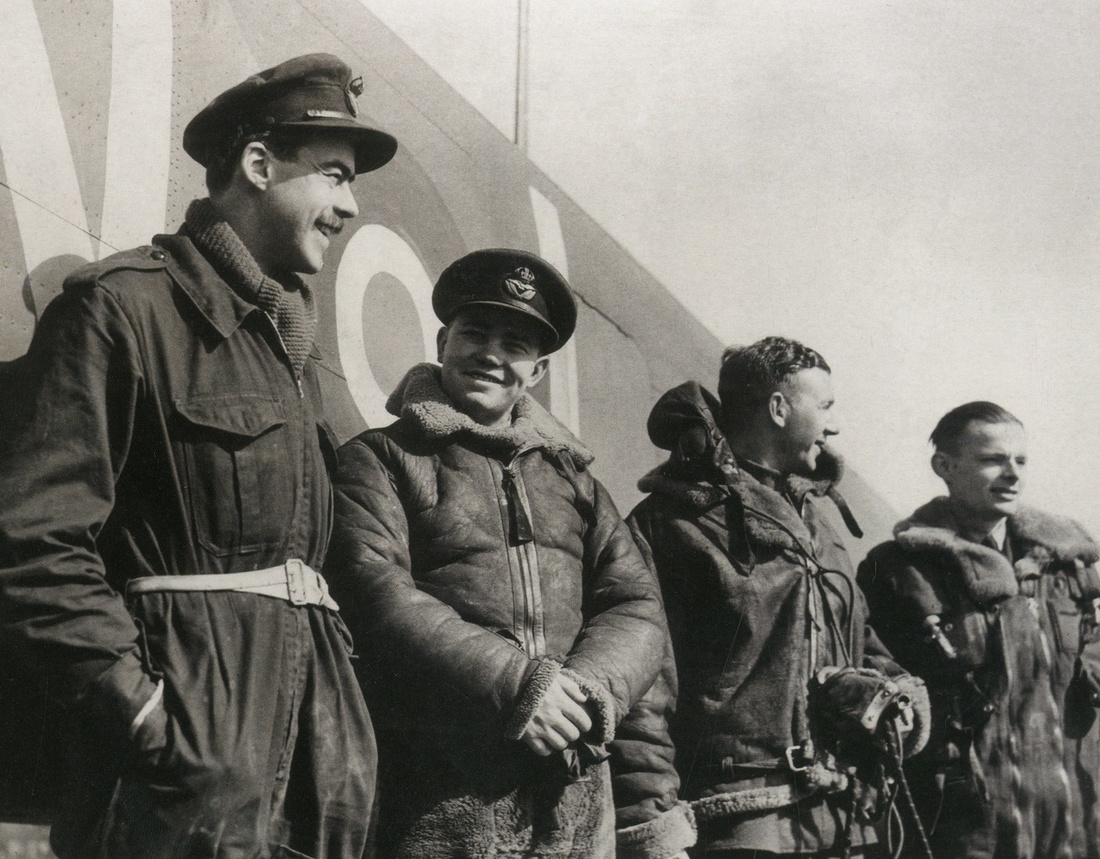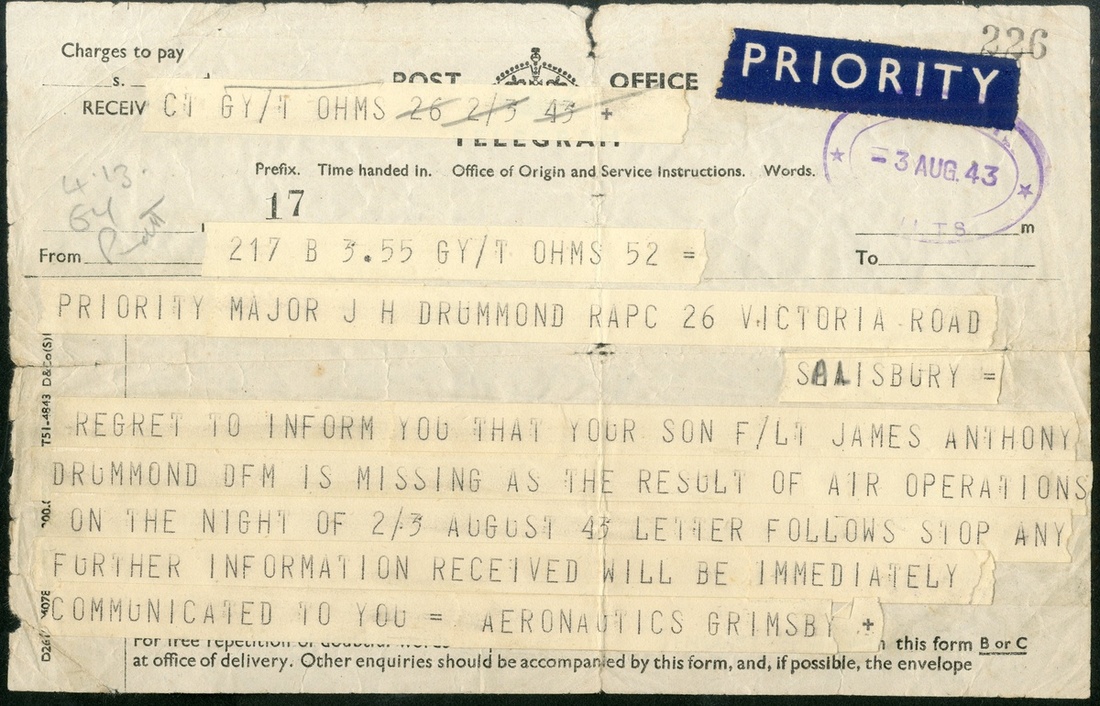Auction: 18001 - Orders, Decorations and Medals
Lot: 23
'This is to say thank you - very inadequately - for all you did while you were my crew. I have two regrets - that you weren't with me long before you were, and that I left you when I did ... I often think of the Squadron and our time in France, and I shall not easily forget May 10th or the 14th. We shouldn't have got out of that contest near Sedan if you hadn't done your stuff so magnificently ...'
Pilot Officer John Hughes, D.F.C., writes to thank his gallant Air Gunner, Sergeant J. A. P. Drummond, D.F.M., for saving his life during the German invasion of the Low Countries in May 1940.
An exceptional and well-documented Advanced Air Striking Force D.F.M. group of five awarded to Flight Lieutenant J. A. P. 'Jimmy' Drummond, Royal Air Force, a rare survivor of the 'massacre of the Battles' in May-June 1940
He was decorated for his cool and accurate gunnery in the face of heavy flak, having gone into action on the first day of the German invasion of the Low Countries and shot down a Me. 109 just four days later: on the latter date - 14 May 1940 - his was the only Fairey Battle of No. 218 Squadron to make it back to base
Yet his subsequent operational career was equally imbued with gallant deeds and considerable flak - he twice had to bale out of damaged aircraft on returning from sorties in Wellingtons of No. 115 Squadron in 1941 - and shot down another Me. 109 during a daylight strike on the Gneisenau at Brest
Remarkably - and having in the interim participated in all three '1000 Bomber Raids' in May-June 1942 - he volunteered for a third operational tour, a tour that witnessed his Lancaster being badly shot-up by night fighters on at least two occasions
His next encounter with an enemy night fighter was to prove his last for - on returning from a Hamburg 'firestorm' raid in July 1943 - his aircraft was shot down over the Frisian Islands: a few days earlier he had written to his parents to say there wasn't much chance of leave 'but I will be home as soon as I can'
Distinguished Flying Medal, G.VI.R. (550408 Cpl. J. A. Drummond, R.A.F.); 1939-45 Star; Air Crew Europe Star; Defence and War Medals 1939-45, together with his Caterpillar Club membership badge, in gold with 'ruby' eyes, the reverse officially inscribed, 'P./O. J. A. P. Drummond', and R.A.F. prize medal for a relay race at Bircham Newton in 1938, inscribed to 'J. A. Drummond', extremely fine (7)
D.F.M. London Gazette 21 June 1940. The original recommendation states:
'On the 10 May 1940, this Air Gunner took part in a low bombing raid on an enemy column near Dippach, and in the face of intense anti-aircraft fire he added greatly to the success of the raid by the full use of his machine-gun on enemy troops.
On the 14 May, when taking part in another raid his aircraft was attacked by a heavy formation of Messerschmitt 109s. With confidence and great courage Corporal Drummond engaged the enemy fighters and as a result of his accurate fire shot down one and inflicted damage on others. His coolness and accurate fire in the face of repeated attacks were to a very great extent responsible for the safe return of his aircraft.'
James Anthony Patrick Drummond was born in Winchester, Hampshire in August 1919, the son of a Staff Sergeant-Major (later Major) in the Army Pay Corps. Educated at St. Joseph's Academy, Blackheath, and at Saint Louis' College, Tientsin, he joined the Royal Air Force as a boy entrant Wireless Operator in September 1935.
Clearly a talented athlete, and 'diligent, trustworthy, intelligent, steady and respectful', he successfully applied for aircrew duties, making his first flight in an old Vickers Victoria troop carrier while attending the Electrical and Wireless School at R.A.F. Cranwell - 'Oh Boy! It was magnificent!'; an accompanying letter refers.
Advanced Air Striking Force - 'massacre of the Battles'
The outbreak of hostilities found Drummond serving as an Air Gunner / Wireless Operator in the rank of Corporal in No. 218 Squadron, a Fairey Battle unit operating out of Boscombe Down. Shortly afterwards, in late September 1939, he was posted to Auberive, France as part of 75 Wing of the Advanced Air Striking Force. Having survived a crash in Battle K9357 at Pommiers on 12 January 1940, he went into action towards the end of the 'Phoney War' period, completing an operational sortie - a reconnaissance of the Rhine - on 22 April 1940, in Battle L5237, piloted by Flying Officer John Hughes.
But it was in the following month that No. 218 Squadron really went into action, following the German invasion of the Low Countries. Indeed it was on the 10th of the month, in an operation against advancing enemy columns at Dippach, that Drummond so effectively used his guns. Four days later, in the face of repeated attacks from Me. 109s, he did even better, bringing one of them down. In a letter dated 29 November 1940, Drummond's pilot, John Hughes, told him of his gratitude, and well he might have - of the Battles of No. 218 that went into action on the 14th, his was the only one to return to base:
'This is to say thank you - very inadequately - for all you did while you were my crew. I have two regrets - that you weren't with me long before you were, and that I left you when I did ... I often think of the Squadron and our time in France, and I shall not easily forget May 10th or the 14th. We shouldn't have got out of that contest near Sedan if you hadn't done your stuff so magnificently ...'
The Operational Records Book for No. 218 Squadron notes that a signal was received on 11 June notifying the award of Drummond's D.F.M., and he was invested with his decoration by Air Marshal Sir Charles Portal at a special parade at R.A.F. Wyton on 29 July 1940. John Hughes received the D.F.C.
Ongoing Ops. - Caterpillar Club
On returning to the U.K., No. 218 Squadron was re-equipped with Blenheims, and Drummond participated in three sorties to Holland over the coming months, on one of which, a photo-reconnaissance of Ostend on 13 September, his aircraft was attacked by three enemy fighters. In November 1940, No. 218 converted to Wellingtons, Drummond completing at least five more sorties to targets in France, Germany and Holland in the period up to July 1941. He had, meanwhile, been commissioned as a Pilot Officer.
Next posted to No. 115 Squadron, another Wellington unit, he went on to complete seven further strikes against German targets, the first and last of them resulting in him taking to his parachute: Wellington W5710 having to be abandoned over Norfolk after a raid to Osnabruck on 9 July 1941, but the pilot stayed at his controls and eventually effected a safe landing, and again, on 27 August, after a raid on Mannheim, when following a large explosion, the entire crew baled out over Cromer, all landing safely. Drummond was duly elected to the Caterpillar Club.
Nor were his intervening sorties without incident, a daylight visit to Brest to attack the Gneisenau on 24 July resulting in flak damage and an engagement with an Me. 109 (which was claimed as destroyed), and a trip to Munich on 11 August resulting in further flak damage.
'1000 Bomber Raids'
Drummond was posted to No. 12 O.T.U. at Chipping Warden in October 1941 and was promoted to Flying Officer in May 1942. But his so-called 'rest' period was rudely interrupted by the advent of Bomber Command's '1000 Bomber Raids' that summer, when he flew in Wellingtons on each of the first such raids against Cologne, Essen and Bremen. The former outing prompted him to write to his parents in the following terms:
'We were all very surprised when all the instructors were told to get together and pick out crews for a little exercise ... We cracked off to Cologne looking for a party and boy did we have one! We saw the place burning 80 miles away - so ripped up, dodged all the other bombers which absolutely filled the sky, let go all of our incendiaries, took some photos. and watched all the fires burning, exploding and breaking out everywhere. Whoopee!! It was really wizard ...'
Another close shave
In August 1942, Drummond was posted to No. 460 (R.A.A.F.) Squadron as a Signals Leader. Converting to the unit's Lancasters, he flew sorties against Essen on 4 January 1943 - when his aircraft was badly damaged by a night fighter - and Berlin on the night of the 16th, when his aircraft was hit by flak. Of the run-in with the enemy night fighter, a local newspaper article states:
'Flying Officer James Anthony Drummond, D.F.M., of Salisbury, was the Wireless Operator in a Lancaster bomber which had a thrilling and adventurous trip to and from the Ruhr on Monday night. Following an attack by an enemy fighter, fire broke out in the Lancaster as the pilot turned for home. The fuselage was raked with bullets and the bomb bay, rudder trim and bomb release gear were damaged. The bomb aimer, a Canadian from Saskatchewan, was wounded in the leg. With the gunners replying to the enemy's fire, the Lancaster's captain took evasive action, and the fighter was eventually driven off. Although damaged, the Lancaster arrived safely back in England.'
Third tour of operations
In May 1943 - and having been advanced to Flight Lieutenant - Drummond joined No. 100 Squadron, flying Lancaster IIIs out of Waltham, Grimsby, once again as Signals Officer. He subsequently participated in eight further operational sorties to targets in Germany and Italy, the former including two trips to Cologne, one to Essen - where his Lancaster was hit by flak - and another brace to Hamburg during the famous "firestorm" raids of late July 1943. On the 29th of that month, Drummond wrote to his parents:
'Got back safely from Hamburg prang and tried to phone you twice yesterday but no reply ... It was the 13th trip of my third lot so I was pleased it was over. It was a grand show though. I have managed to slip my name in for a specialist signals course - it last 5 weeks - and I have got to go to Penrhos in Wales when it comes off. I have only 7 more trips to do and cannot do any more for the next year or so after that ... I am afraid that there isn't much chance of leave but I will be home as soon as I can ...'
Journey's end
Sadly, it was not to be: on his very next sortie - another "firestorm" raid to Hamburg on the night of 2-3 August 1943 - his Lancaster failed to return, subsequent investigation suggesting that it most likely fell victim to an enemy night fighter piloted by Oberleutnant Hermann Greiner of IV/NJG1. The Lancaster crashed off the Dutch Frisian Islands, and only one body was ever recovered, that of a Canadian Sergeant.
In subsequent letters to Drummond's father, a Wing Commander R. V. McIntyre stated:
' ... I had a short talk with him at his aircraft before he took off, and he was in great spirits as were they all in that very capable experienced crew, of which I hope favourable news will be forthcoming soon ... During the time that Jimmy was with us he proved himself to be a most capable Signal's Leader and it will indeed be most difficult to find a man to fill the post in the way he did. He was very popular with everybody, and we all desire to express our deepest sympathy ...'
Sold with an impressive - and poignant - archive of original documentation, comprising:
(i)
Several pre-war school reports and / or athletic meeting programmes.
(ii)
Six of the recipient's handwritten wartime letters, 1940-43; see above quoted examples.
(iii)
A congratulatory letter from the Chief of Air Staff on the award of his D.F.M., dated 22 June 1940.
(iv)
A Government 'Absolute Priority' telegram recalling him from leave to R.A.F. Oakington, dated 7 September 1940.
(v)
A letter of thanks from his 218 Squadron pilot, John Hughes, dated 29 November 1940; see above quote.
(vi)
A forwarding letter from No. 115 Squadron for the recipient's Caterpillar Club membership badge, dated 24 October 1941 ('How are things with you old boy? Don't forget to look us up when you have a chance ...').
(vii)
A letter from a friend at No. 1 Group, informing him of his temporary posting to No. 460 Squadron as Signal's Leader, dated 16 August 1942.
(viii)
A Moss Bross, Covent Garden receipt for the purchase of his R.A.F. Officer's 'tunic and slacks, A./G. Wing and rank braid', dated 8 May 1943.
(ix)
Assorted wartime newspaper cuttings.
(x)
A quantity of poignant correspondence regarding his loss in action in August 1943, comprising the original telegram notifying his parents, dated 3 August 1943, and nine related letters; see Squadron C.O's example quoted above.
(xi)
Air Ministry condolence certificate forwarding his campaign awards, in the typed name of 'Flight Lieutenant J. A. P. Drummond, D.F.M.'; Buckingham Palace condolence message , addressed to the recipient's father; and official illuminated memorial scroll in the name of 'Flight Lieutenant J. A. P. Drummond, D.F.M., Royal Air Force', with related Ministry of Pensions communication, dated 16 August 1947.
Subject to 20% VAT on Buyer’s Premium. For more information please view Terms and Conditions for Buyers.
Estimate
£4,000 to £5,000











